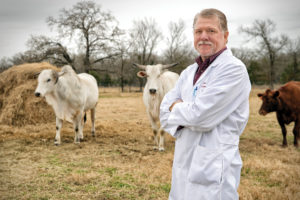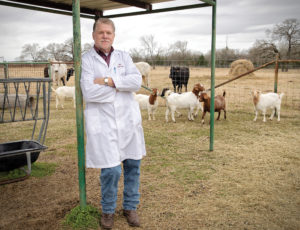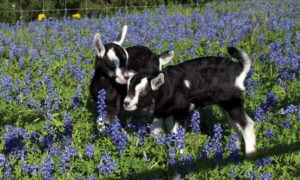A ‘Long’ Shot
Through a variety of projects focusing on reproductive science‚ Dr. Charles Long works to expand horizons in large animal research in a way that will benefit animals‚ industry‚ and humans.
Story by Vandana Suresh
Dr. Charles Long, a professor in the Department of Veterinary Physiology & Pharmacology (VTPP) in the College of Veterinary Medicine & Biomedical Sciences (CVM), has dedicated his career to expanding the scope of reproductive science research at Texas A&M University.

Since starting his own research group 15 years ago, he has worked on a variety of projects to satisfy his intellectual curiosity, tackling diverse topics that range from developing assisted reproductive techniques for livestock to investigating early embryonic development.
Long was always certain he wanted a career in animal sciences. Growing up on a small dairy farm in southern Missouri, he developed a close understanding of animal agriculture at a young age.
“Dairy farming, cattle operations, pig operations, I worked on all of those things,” he said.
Hence, when it came time to pick a major for his undergraduate degree at the University of Missouri, he was quick to choose animal sciences.
During his undergraduate years, courses on reproductive biology and genetics piqued Long’s interest. To explore his newfound interest further, he applied for a work-study position in a research laboratory that was studying the genetics of reproduction.
This research experience made a lasting impression on Long.
“The whole idea of experimental design and doing experiments that no one else had done—that was pretty fascinating to me,” he said.
Although Long greatly enjoyed research, the decision to pursue it at the graduate level was made on his behalf.
“I was in the lab and my adviser comes in and says, ‘I signed you up for grad school today. You’ve got to take your GRE and some other things, but you will start graduate school as soon as you are done with your undergrad,’” he said.
For his master’s project, Long studied the genetic mechanisms that control uterine size in mice. He also picked up a new experimental technique following graduate school—cloning.
“I was really excited about the potential of cloning,” he said. “My background in genetics allowed me to see the potential of using clones and assisted reproductive technologies to improve livestock, particularly cattle, sheep, goats, and pigs.”
Shortly after obtaining a master’s degree, he joined Granada BioSciences, a cattle-cloning company. During his time at the company, Long became interested in the biological underpinnings of cloned animals, particularly the environmental factors that affect their embryonic development.
However, he found it difficult to pursue these questions in industry. Thus, he decided to go back to academia. For his doctoral project, at the University of Massachusetts-Amherst, he investigated the differences in the development of embryos produced from cloning versus normal fertilization.
After his Ph.D., Long spent two years as a post-doctoral fellow at the United States Department of Agriculture. Then, after spending another six years in industry, Long decided to leave it for good and join a research-driven academic institution.
“I wanted a position where I could direct my own research program,” he said.

HORSING AROUND
Since joining the Reproductive Science Laboratory at Texas A&M in 2004, Long has worked alongside students and collaborators on a number of research projects. Currently, two of his projects are funded by the Link Equine Research Endowment.
In one project, led by graduate student Carlos Pinzon, his team is using genetic and cloning technology to prevent a disease called glycogen branching enzyme deficiency (GBED) in horses.
GBED is an inherited genetic disorder. Newborn foals with GBED perish because they cannot properly store sugar in their bodies.
To prevent GBED, Long’s group removes the faulty gene that causes GBED from a carrier stallion and replaces it with the correct version. The team then makes clones of these gene-corrected cells to ensure that stallions do not have GBED.
“These stallions cannot transmit GBED to their foals because they do not have the genetic mutation anymore,” he explained.
For the second equine project, Long’s graduate student Cassandra Skenandore is studying how well new anti-inflammatory treatments relieve arthritis. Similar to humans, horses also suffer from diseases caused by excessive inflammation.
“Currently, there are a lot of drugs on the market for treating human inflammatory disease, but there are limited options for horses,” she said.
Long noted that the goal of this project is to develop equine-specific therapeutics.
“We would like to be able to develop biotherapeutic molecules that are specific to horses,” he said. “And so, if the animal has arthritis or other inflammatory diseases, these molecules could be used to improve their quality of life.”
PUTTING THE ‘FOOD’ IN FOOD ANIMAL
Long is also devoting his research prowess to solving serious problems within the cattle industry, as well as to projects that have translational implications.
In one of those projects, funded by the Texas A&M AgriLife Research, Long, in collaboration with fellow VTPP professor Dr. Mark Westhusin, is using genetic technology to make cattle less susceptible to bovine respiratory diseases (BRD) or shipping fever. BRD is estimated to cost the cattle industry billions of dollars each year.
To treat BRD, veterinarians often use antibiotics. However, most antibiotics have side effects.
“When you use antibiotics, you not only kill the bacteria that is producing the toxin, but you also start affecting all of the animals’ microbiome, particularly the good bacteria that is keeping these animals healthy,” Long said.
To minimize the use of antibiotics, Long’s group is making small genetic changes in the cattle genome so that these genetically engineered animals are less susceptible to the BRD-causing bacteria.
While many of Long’s projects focus on improving health of large animals, he is also working on a project that has a direct impact in human medicine. He and his team have genetically engineered goats to produce proteins called antigens in their milk. In particular, these antigens can be used for developing vaccines against malaria.

Long pointed out that purifying antigens from goat milk is a cost-effective method of producing malaria vaccines. Furthermore, he explained that with global temperatures on the rise, infectious diseases such as malaria have the potential to spread to countries that lie beyond the tropics, like the United States.
“It’s getting hotter in places where it wasn’t before,” he said. “That’s going to cause the pattern of disease outbreaks to change, as well. You just have to be prepared for that sort of thing.”
Through his diverse research projects, Long has established enduring collaborations with researchers within Texas A&M University and at other institutions. He says he values these relationships tremendously.
“I have had the good fortune of working in the reproductive sciences group from the day I started at Texas A&M University,” he said. “It has been incredibly rewarding to work with my colleagues Drs. (Michael) Golding, Westhusin, and (Duane) Kraemer.”
As a research mentor, Long enjoys working with his students in developing their research ideas. His students look up to him as a source of inspiration and motivation.
“One thing that Dr. Long always says is, ‘Never let the sun go down without making some kind of progress.’ The biggest lesson that he has tried to instill in me is to just do it,” Skenandore said.
###
Note: This story originally appeared in the 2019 Spring edition of CVM Today.
For more information about the Texas A&M College of Veterinary Medicine & Biomedical Sciences, please visit our website at vetmed.tamu.edu or join us on Facebook, Instagram, and Twitter.
Contact Information: Jennifer Gauntt, Interim Director of Communications, Media & Public Relations, Texas A&M College of Veterinary Medicine & Biomedical Science; jgauntt@cvm.tamu.edu; 979-862-4216


